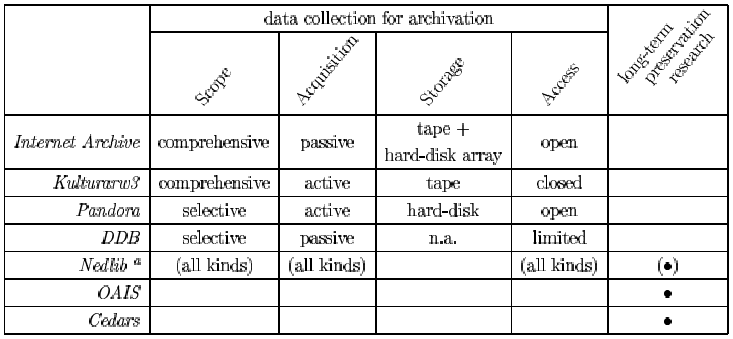
Together with the growing awareness of the problems that lie in the long-term retention of digital material and consequently the threat of loosing our common memory, also the number of projects embarking on the preservation of our digital cultural heritage is rising.
Apart the spear-heading Internet Archive (cf. Section 3.1), foremost libraries were first to take action being subject to an extension of their duties to the digital domain. Early initiatives include the Pandora-project (cf. Section 3.3), "Our Digital Island" by the State Library of Tasmania, and the Nordic Web Archive (NWA), which is a cooperation of the national libraries of Iceland, Sweden (cf. Section 3.2), Finland, Norway, and Denmark. Recently, other national libraries have officially inaugurated projects in this field, too, including those of France, England, Germany (cf. Section 3.4), the Czech republic, Canada, and the Minerva-prototype at the Library of Congress in Washington, USA.
In general, other government agencies are only just beginning to understand the new challenges. Of course, NASA is an exception to this, since it experienced the urgency of the task first-hand when 20 percent of the 1976 Viking Mars Mission data were found to be unreadable [Ste98]. Consequently, it is promoting the development of the OAIS-model (cf. Section 3.6).
In companies the threat that comes with archiving documents has not spread sufficiently at this point of time. Only few commercial projects addressing this issue can be traced. A prevailing position takes IBM, building a storage system for the deposit of electronic publications ('Depot van Nederlandse Elektronische Publicaties', DNEP) at the national library of the Netherlands [NS01]. Kodak has discovered the permanent accessibility of digital material as an emerging market, too. It offers a "Digital Insurance for Information at Risk"[Law01] in the form of so-called "Integrated Imaging-Products". Basically, this solution builds on printing documents and retaining the paper employing the strategy of Change Media (cf. Section 2.4.1).
Scholarly research in the fields surrounding long-term preservation of digital information has been installed at various sites. The Digital Rosetta Stone is a project pursuing a slightly different approach to those introduced in Section 2.4. It trusts that digital documents can be interpreted in their native file format if a detailed description of it is retained [HR00]. Therefore, knowledge preservation of the file format and data recovery of the original file represent the core process in the reconstruction of documents.
As a prerequisite to preservation strategies, providing a well structured and stable archive environment is seeked. Naturally, equipment, resources, and the specific requirements influence archival processes making each solution unique. However, building on a common strategical framework facilitates not only the establishment of the system, but also its maintenance and allows tight cooperation with other projects.
Projects in this broadly defined field include the InterPARES-project (International Research on Permanent Authentic Records in Electronic Systems) [GSE00], and Project Prism at Cornell University [LK00]. Both are looking at digital preservation as a process integrated in an extended solution, and both work with a multi-disciplinary team.